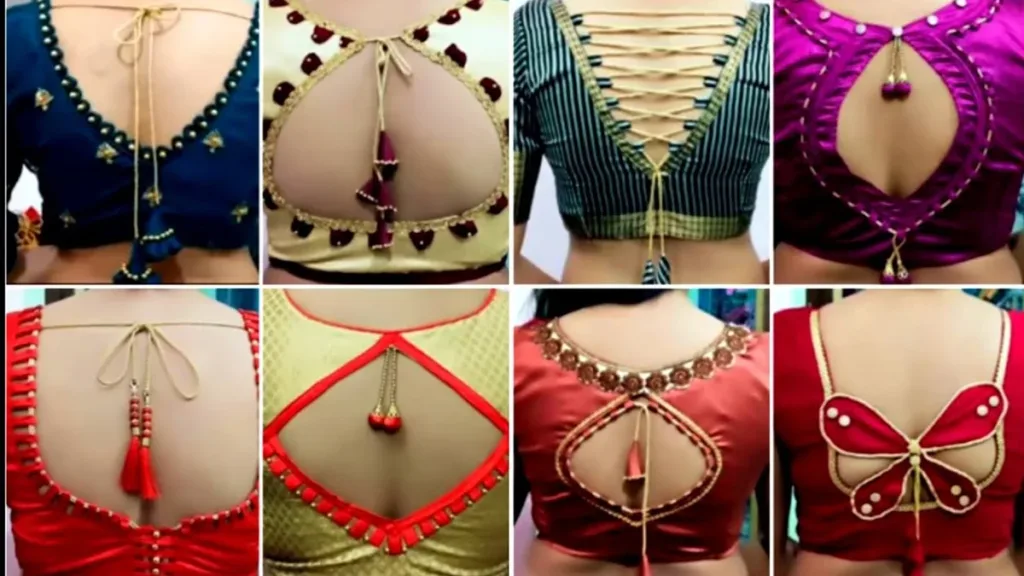Types of blouses- The true beauty of sarees flickers only when they are paired with the right blouses. You must wonder how an ordinary-looking saree becomes gorgeous for some people! It is because of the beauty of the right blouses.
However, it becomes a tough task for us to choose the right blouses for the given sarees fabrics, and our struggle takes its height when we keep on browsing for the best designs. For all those strugglers all around, this article can be a great help understand about types of blouses. Let’s dive deep into blouse fashion and get the best of it in this article!
Different Designs of Blouses
Designs of Blouses- Blouses come in various styles and designs, catering to different preferences and occasions. Here are some common types of blouses:
Button-Up Blouse: This classic style features a front opening with buttons and a collar. It can be made from various fabrics and is versatile for both formal and casual wear.
Peasant Blouse: Inspired by traditional peasant attire, this blouse is usually loose-fitting, with billowy sleeves and a gathered neckline. It often has decorative elements like embroidery or tassels.
Wrap Blouse: This blouse has a front closure that wraps across the body and ties at the side or back. It creates a flattering V-neckline and can be made from different materials, ranging from casual to dressy.
Ruffled Blouse: Ruffles are a defining feature of this blouse style. They can be found on the neckline, sleeves, or down the front. Ruffled blouses add a feminine and romantic touch to any outfit.
Off-the-Shoulder Blouse: This trendy style exposes the shoulders and collarbone, with sleeves that typically rest below the shoulders or are completely detached. It gives an alluring and fashionable look.
Peplum Blouse: A peplum blouse has a fitted bodice that extends below the waistline, flaring out into a short, gathered, or pleated overskirt. It accentuates the waist and adds a touch of elegance.
Sleeveless Blouse: As the name suggests, this blouse lacks sleeves, providing a more casual and breezy look. It can come in various necklines, such as scoop neck, V-neck, or high neck.
Tunic Blouse: Tunics are longer blouses that typically extend below the hips. They can be worn with pants or leggings and are often loose-fitting and comfortable, making them popular for casual occasions.
Sheer Blouse: Sheer blouses are made from transparent or semi-transparent materials, such as chiffon or lace. They can be worn alone or layered with camisoles or tank tops for more coverage.
Embellished Blouses: These blouses feature intricate details like sequins, beads, embroidery, or lace appliques. They are perfect for special occasions or when you want to make a statement.
Remember, fashion trends evolve, and new blouse styles emerge regularly, so this list represents some common types but is by no means exhaustive.
Also, the most important thing is whether the designs of blouses you are choosing is suitable to your figure, whether it will be breathable or comfortable to you, or whether it will complement the fashion you are striving for is equally important to make you look gorgeous. That is why you should be very cautious in selecting the right tailoring and fitting partner.
Why is tailoring for the right blouse designs?
The intellect always cuts and divides like a pair of scissors. The heart sews things together and unites like a needle. The tailor uses both.
Mata Amritanandamayi
This beautiful quote becomes more prudent when it comes to blouse designs.
Tailoring and fitting play a crucial role in creating beautiful blouses and giving you a true sense of fashion.
Let’s know the role in deep!
Customization: Tailoring allows for customization, ensuring that the blouse fits perfectly and complements the wearer’s body shape. A well-tailored blouse can enhance the overall appearance and highlight the wearer’s best features.
Proportions: Tailoring helps achieve the right proportions by adjusting the blouse’s length, width, and shape. This ensures that it flatters the wearer’s body and creates a balanced and harmonious silhouette.
Comfort: A well-fitted blouse not only looks good but also feels comfortable to wear. Tailoring takes into account factors such as ease of movement, shoulder width, sleeve length, and neckline, ensuring that the blouse allows for comfortable mobility while still maintaining an elegant look.
Fabric Draping: Tailoring involves understanding the behavior of different types of fabrics and how they drape on the body. A skilled tailor can manipulate the fabric to create pleasing folds, pleats, and gathers, enhancing the overall aesthetic appeal of the blouse.
Details and Finishing: Tailoring allows for the precise execution of design details and finishing touches. This includes elements such as collar styles, cuffs, button placement, and embellishments. Attention to these details can elevate the blouse’s appearance and make it visually appealing.
Versatility: Tailoring allows the customization of blouses to suit various occasions or personal preferences. By considering factors like sleeve options (long, short, or sleeveless), neckline variations, and hemline choices, a tailor can create versatile blouses that can be styled differently to suit different outfits and settings.
Correcting Fit Issues: Tailoring is especially valuable when addressing fit issues. It allows adjustments to be made for common fit problems like gaping at the bust, tightness in certain areas, or excessive fabric bulk. A tailor can modify the pattern and make alterations to ensure a flawless fit that enhances the wearer’s body shape.
Overall, tailoring and fitting are essential steps in creating beautiful types of blouses. They enable customization, enhance comfort, improve proportions, and refine the details, resulting in garments that look great and make the wearer feel confident and stylish.

